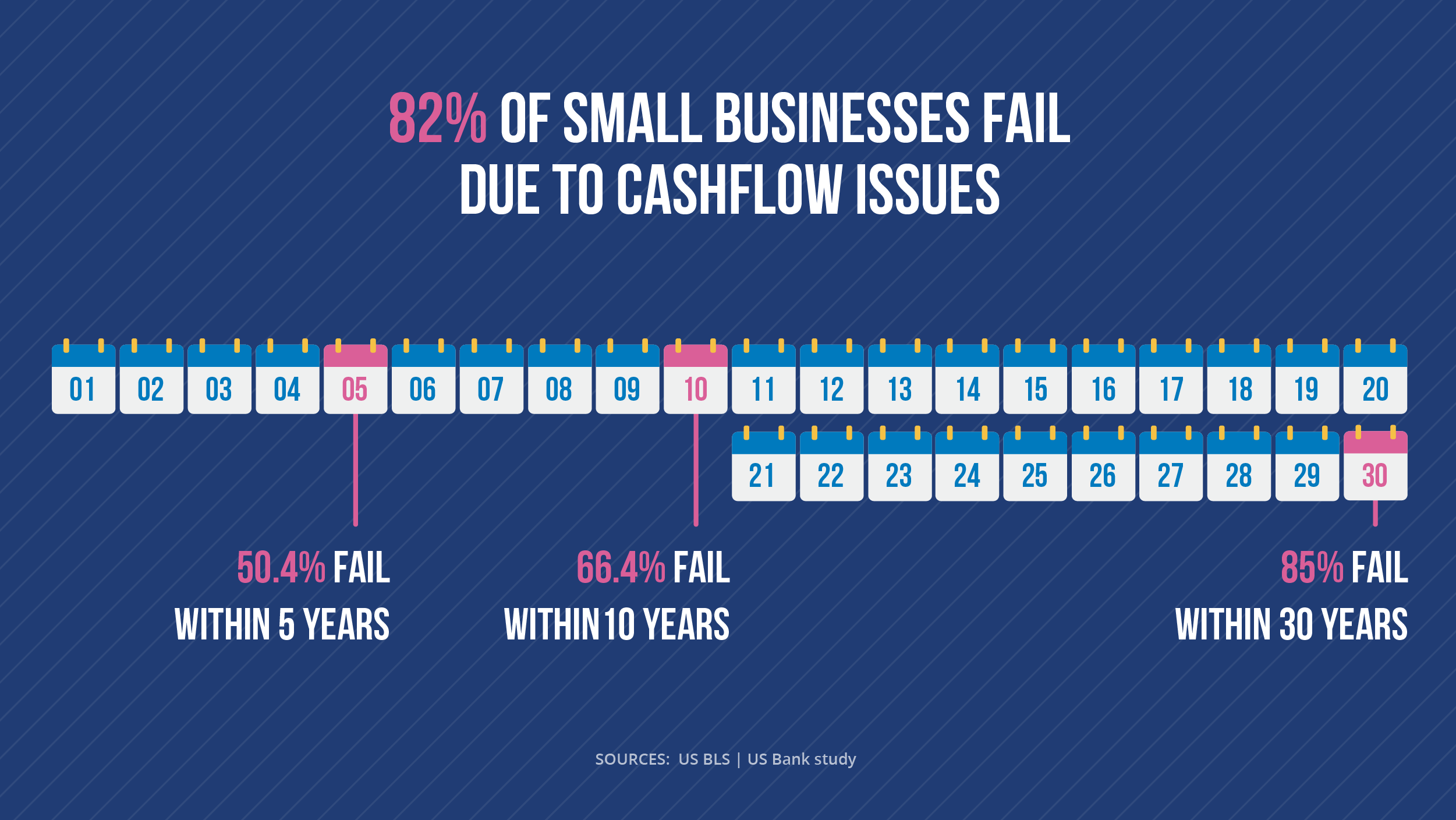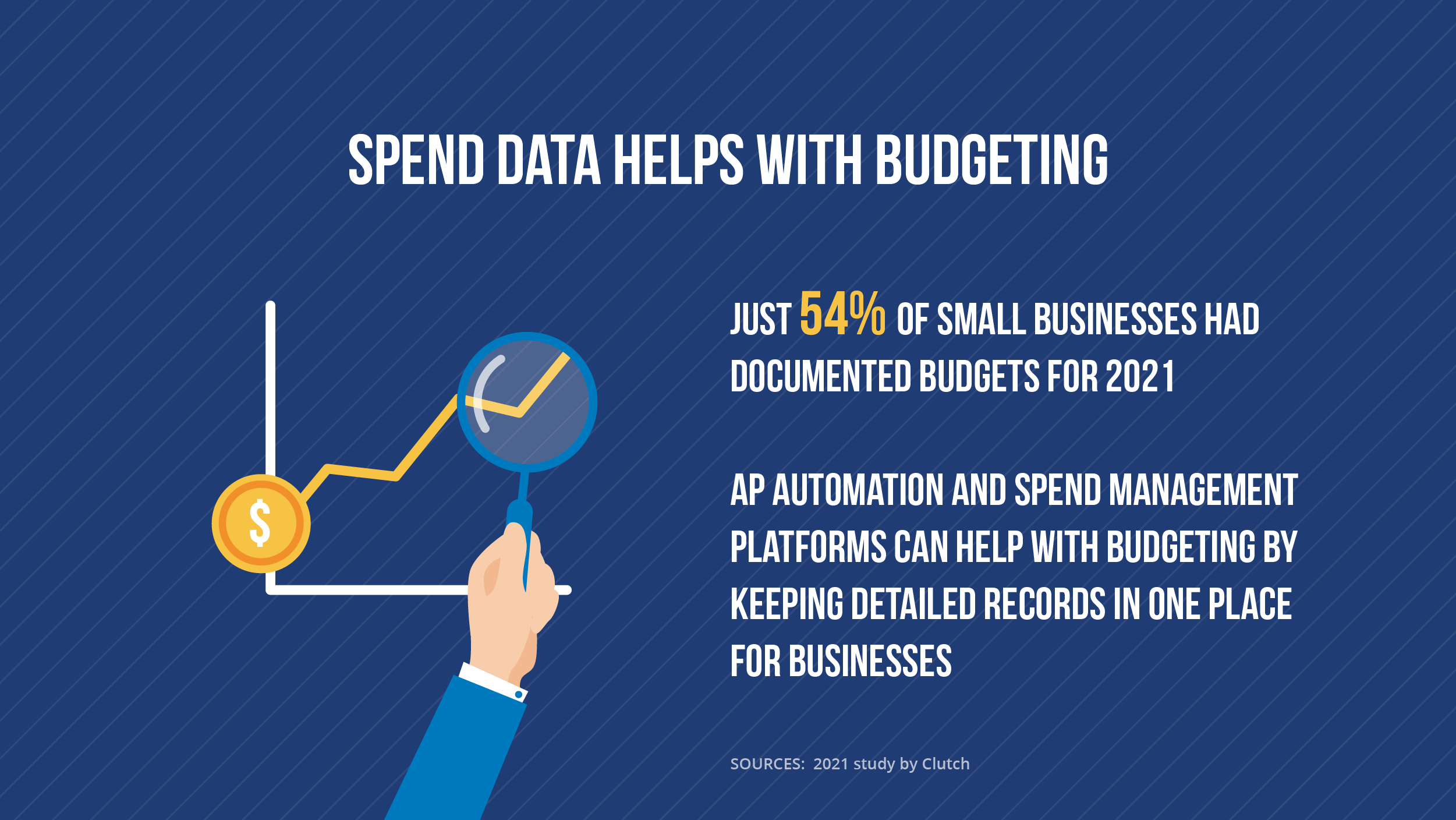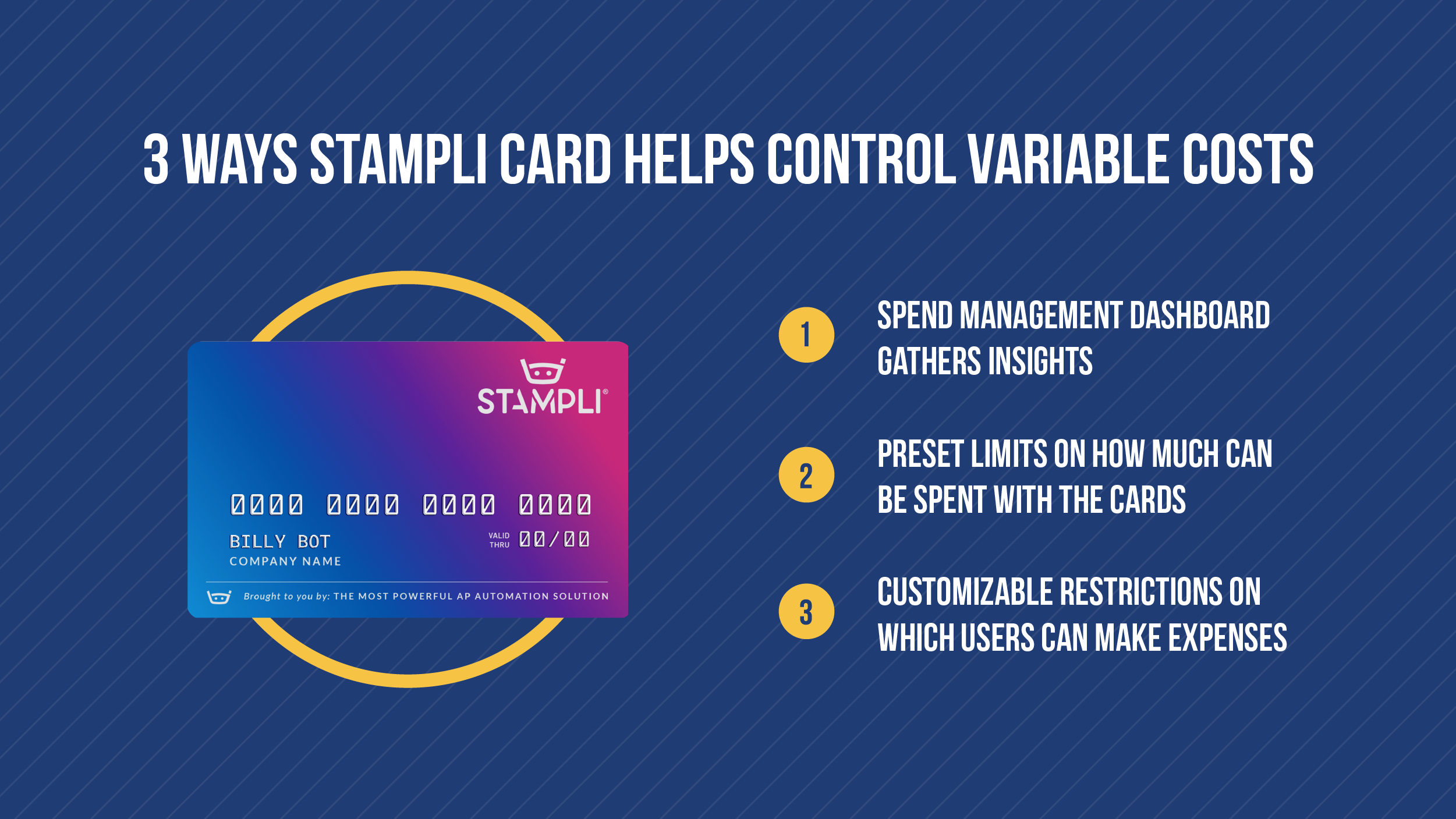Controlling Variable Costs: Strategies to Manage Variable Costs

In business, not every expense will be a fixed cost, or something that will be the same month in and month out. Variable costs, from high power bills in the summer to fluctuating prices of raw materials, can regularly pop up, threatening unprepared businesses.
Today, we’re going to look at how businesses can navigate these periodic rough waters and find ways to control and reduce their variable costs.
We’ll look at a number of different strategies for controlling and reducing variable expenses, including through the use of payment solutions like Stampli Card. Join us as we explore how businesses can manage variable costs more effectively.
Basics of Variable Costs for Businesses
Most businesses incur variable costs, which are expenses that change periodically.
For instance, consider any business with goods to distribute. AAA noted that as of June 2, 2022, the average gallon of gasoline in the United States cost $4.72, with prices over $6 a gallon in some parts of the country.

While this represents a high point in recent years, it’s not unusual for gas prices to fluctuate. In fact, prices change often, if not continually. And when gasoline costs more than normal, the price can be passed along to companies from their vendors and suppliers who must pay more at the pump.
This is just one thing that can affect variable costs. In general, examples of variable costs can include:
- Gasoline;
- Raw materials;
- Utilities such as electric and natural gas (with small business rates for the latter increasing 14% in January 2022);
- Office supplies;
- Business expenses such as client dinners that can increase sales but sometimes affect the bottom line in the short-term;
- Production costs that can correlate with times of higher sales volume;
- Operating costs;
- COGS, or cost of goods sold, which isn’t as static as it might sometimes seem, and can vary based on some of the other factors listed here;
- IT costs if it’s outsourced and there’s a spike in need;
- Interest rates on loans that aren’t fixed;
- Fees for certain professional services, such as legal retainers;
- Costs for temporary staff or additional direct labor during times of production increases;
- Insurance premiums, particularly after a claim is filed;
- Internet cost-per-click advertising, which can spike due to traffic surges or click fraud;
- Inflation, which historically averages 3.2% but is currently hovering around 8% and, while not a direct expense for businesses, can reduce purchasing power.
There can also be a range of semi-variable costs that fluctuate, but at more predictable intervals. They aren’t quite fixed expenses but, as we’ll explore more a bit later, they can almost be treated as such over long enough time intervals.
All of this being said, let’s look at some more of the basics associated with variable expenses for businesses.
Why it’s Important to Manage Variable Costs
When a business opens, it’s already got a tough road ahead of it. The United States Bureau of Labor Statistics notes that for private sector businesses that opened in March 1994, about 50.4% ceased operations within five years, 66.4% were gone by the decade mark, and only 15% still existed by March 2021.

One of the biggest reasons that companies go out of business: cash flow problems, with a U.S. Bank study finding that a staggering 82% of small businesses fail due to cash flow. The sad truth is that businesses won’t be able to get lines of credit every time they need them, or rely on payment extensions from their suppliers. There will be times they need to have money to pay up.
Accordingly, businesses will want to do anything they can to help minimize their exposure to potential cash flow issues. There are a variety of strategies that businesses can pursue, but one important tactic is reducing or otherwise seeking to minimize variable expenses.
Even if it’s not a matter of corporate life and death for companies, it’s still good to rein in variable costs. Reducing variable costs frees up money that can be allocated for better purposes, such as employee bonuses or business expansion.
How Variable Costs Can Spin Out of Control
Variable costs generally spin out of control one of two ways. There are the cost spikes that are beyond a company’s control, such as the recent increase in the cost of gasoline, caused by a number of factors including war and increased overseas demand for gas.
In these cases, there is little that a company can do to control these price fluctuations. The businesses can only make adjustments on their end. If the business does its own distribution, it may be able to purchase more fuel-efficient vehicles or have drivers plan routes to minimize the number of miles traveled. Otherwise, there’s just not much a company can do with the first type of variable cost fluctuation.
Other times, however, a business will have more options when variable costs emerge, as they change for factors more within a company’s control. These factors can include the mood of suppliers, price runs on premium (but substitutable) raw materials, and changes in insurance rates.
Next, we’re going to explore what a business can do to keep its variable costs under control.
5 Business Strategies to Manage Variable Costs
The good news for businesses when it comes to managing their variable expenses is that often, they’re not powerless. Business owners don’t have to engage in austere cost-cutting measures or desperate short-term fixes. Here are five strategies to consider:
1. Get Serious About Budgeting
Seemingly, every business would be experts in budgeting, getting all of their projected expenses down on paper and matching spending to cash flow. However, a 2021 study found that just 54% of small businesses had documented budgets for 2021. A press release for the study noted, “The data reveals that most businesses do have budgets, but that the smallest businesses are more likely to go without them.”
Sadly, the smallest of companies are also the most likely to be waylaid by a variable cost they didn’t anticipate because they didn’t budget for it or calculate the break-even point they needed to stay above. But companies of all sizes can protect their interests by undertaking some simple budgeting, with NerdWallet listing an easy six-step guide for small businesses (with determining variable costs as the third step.)

Another thing to consider is that for businesses using AP automation or spend management platforms, they don’t necessarily have to write out a budget. The systems can compile budgets by gathering the data in one place.
2. Average Variable Costs Out Over Timespans
The thing about variable costs is that over a long enough period of time, they often aren’t truly random. Patterns can emerge, with a business being able to average their variable expenses out.
For example, while an electricity bill might be higher for a business during output increases, the bill can be lower during more normal production levels. Thus, a business can take an average of several months (preferably, at least a year) and then give itself a buffer for the months the bills run high.
A good rule of thumb for the size of the periodic variable expenses buffer is to deduct the average monthly expense from the highest bill in the most-recent 12-month period. Say, if the average is $100 and the high bill is $300, a $200 buffer probably makes sense, though it can also be smart to increase the buffer size.
3. Be Wary of Cost-Per-Click (CPC) Advertising
Cost-per-click advertising can have its place in business, though with the volatility in click rates that can occur, it’s best to proceed cautiously with it. Otherwise, both total costs and a company’s net income can suffer rapid adverse effects.
Google, the giant of search engine advertising, has some protections in place for CPC campaigns, helping businesses to not burn through their budgets all at once. For example, businesses can set maximum bids for keywords. Companies can also look to bid on less competitive and more longtail keyword phrasings, with other tips available.
Companies can also look to do their own organic SEO or social media marketing efforts so that they aren’t getting charged for every click to their website.
4. Regularly Review Product and Service Providers
Sometimes when variable costs are spinning out of control, it’s because a less than honorable supplier has decided to extract every dollar they think they’re entitled to.
While most suppliers are honorable and increase variable rates for their goods or services only when necessary, it’s good for businesses to still periodically review who they’re doing business with. One way to do this is through AP automation software that can give businesses a quick look at their suite of vendors and show any outliers with charges. This is also a good way to gauge for possible signs of fraud.
5. Use Virtual or Ghost Payment Cards
Virtual or ghost cards are an emerging form of payment, with 4% of companies citing them as their preferred way to pay suppliers in a 2021 study, “How & Why Companies Choose Payment Types.” This form of payment, which allows businesses to pay bills with individualized cards, might not be ubiquitous yet, but it can be excellent for controlling variable costs.

Virtual or ghost cards often come with electronic dashboards that provide acute tracking and spend management insights. These types of cards also have built-in controls to help combat variable spending at the source.
It’s why virtual cards like Stampli Card are an outstanding way for businesses to protect against wildly fluctuating variable costs.
How Stampli Card Helps Businesses Control and Reduce Variable Costs
For businesses ready to take control and move variable expense management to the next level, here are a few ways Stampli Card, our virtual payment solution, can help.
Limit Variable Spending Before it Occurs
Stampli Card offers excellent spending controls. Companies can limit variability in their purchases by restricting use of these cards to only authorized personnel. These users can spend up to and only amounts that companies set, with one-time cards able to be printed for specific transactions.
The strong protections prevent rogue employees from being able to cause chaos, and minimize wildly oscillating payables balances. Variable spending can be halted before it ever happens.
Track Spending as it Happens
Another of the best ways to keep a lid on variable cost spending is to know when it’s occurring, not weeks or months after the fact when a bank or credit card statement arrives.
With Stampli Card, a company’s management, such as CPAs, CFOs, and other leaders, can get alerts the moment their authorized personnel make purchases. This way, companies know right away if something is out of whack with their procurements or operating costs.
Spend Management Insights Gathered in One Place
Awareness using Stampli Card doesn’t stop at the time spending occurs. All of the data is instantly gathered in an easy-to-use spend management platform.
Businesses will have keen insights for all of their spending, whether variable, fixed, or other classification, in just a few clicks. It’s a great start for controlling and reducing variable costs and heading toward a brighter business spending future.
Stampli Card: A great strategy to reduce variable costs. Try it today.